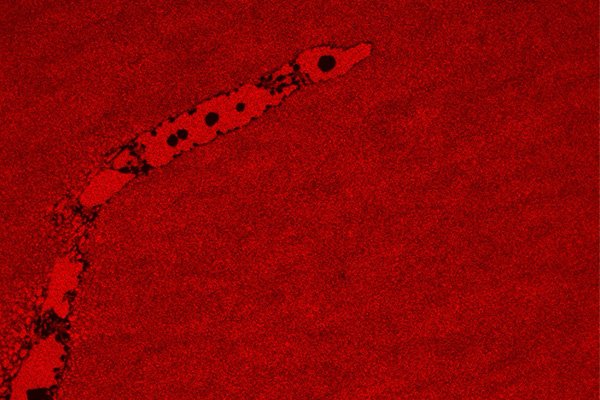2023-03-12 ミネソタ大学

This Image shows the lung surfactant, a complex composed of fats and proteins generated in the lungs, after being exposed to the lysolipid in water where the bright red spots indicate the lysolipid replacing the lung surfactant in a layer of cells. Image credit: Zasadzinski Research Group, University of Minnesota Twin Cities
<関連情報>
- https://cse.umn.edu/college/news/study-provides-new-insights-deadly-acute-respiratory-distress-syndrome-ards
- https://www.pnas.org/doi/10.1073/pnas.2309900120
肺サーファクタントの界面力学の進化は急性呼吸窮迫症候群の進行を模倣する Evolution of interfacial mechanics of lung surfactant mimics progression of acute respiratory distress syndrome
Clara O. Ciutara, Steven V. Iasella, Boxun Huang, +1, and Joseph A. Zasadzinski
Proceedings of the National Academy of Sciences Published:December 12, 2023
DOI:https://doi.org/10.1073/pnas.2309900120
Significance
There is no known mechanism for the initiation and progression of acute respiratory distress syndrome, which has a 40% mortality rate and is one of the major complications of advanced COVID-19 infections. Here, we show that an increased concentration of lysolipids produced by the innate immune system during inflammation can inhibit the surface tension and dilatational properties of lung surfactant, leading to mechanical instabilities during lung inflation or deflation.
Abstract
How acute respiratory distress syndrome progresses from underlying disease or trauma is poorly understood, and there are no generally accepted treatments resulting in a 40% mortality rate. However, during the inflammation that accompanies this disease, the phospholipase A2 concentration increases in the alveolar fluids leading to the hydrolysis of bacterial, viral, and lung surfactant phospholipids into soluble lysolipids. We show that if the lysolipid concentration in the subphase reaches or exceeds its critical micelle concentration, the surface tension, γ, of dipalmitoyl phosphatidylcholine (DPPC) or Curosurf monolayers increases and the dilatational modulus, E∗(ω), decreases to that of a pure lysolipid interface. This is consistent with DPPC being solubilized in lysolipid micelles and being replaced by lysolipid at the interface. These changes lead to 2E∗-γ<0, which is the criterion for the Laplace instability that can lead to mechanical instabilities during lung inflation, potentially causing alveolar collapse. These findings provide a mechanism behind the alveolar collapse and uneven lung inflation during ARDS.


